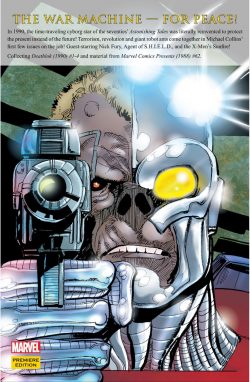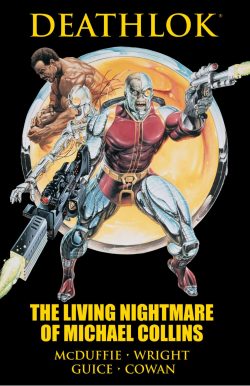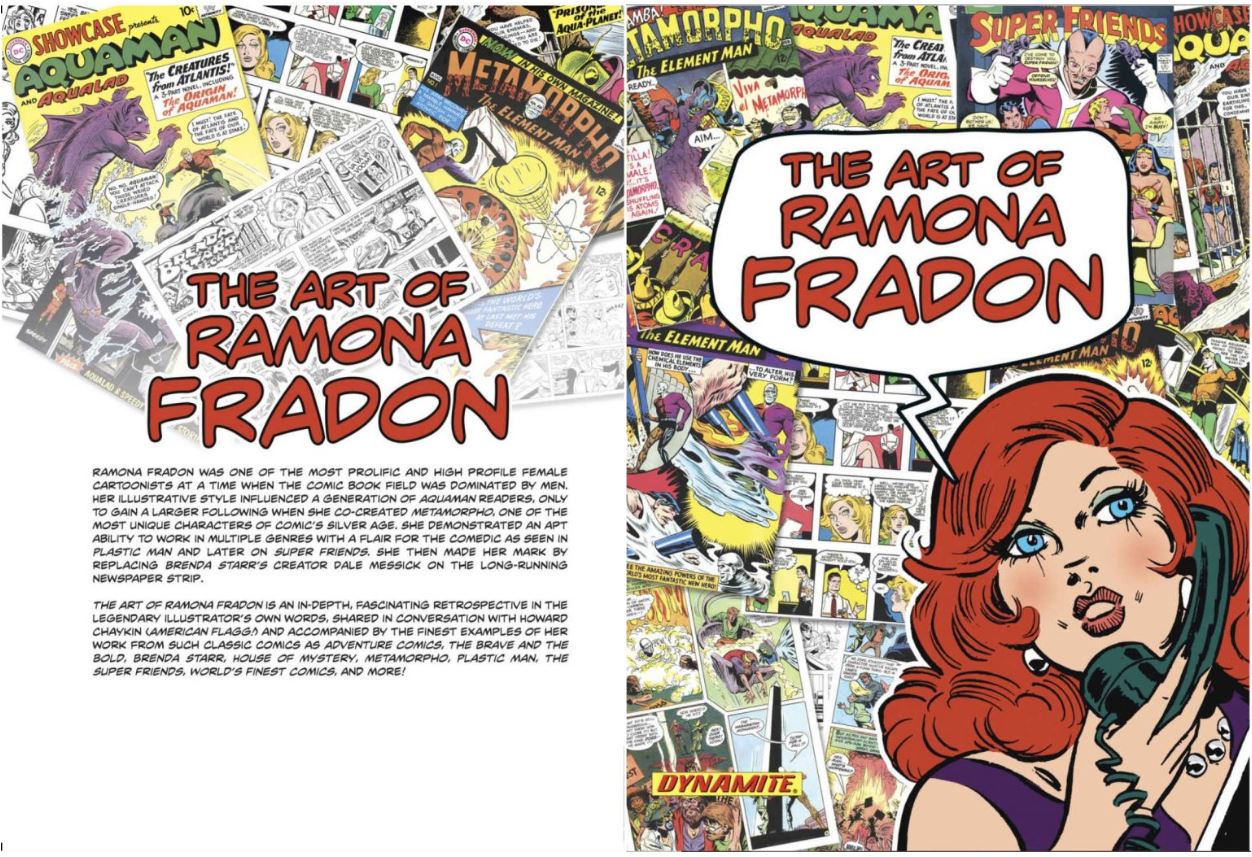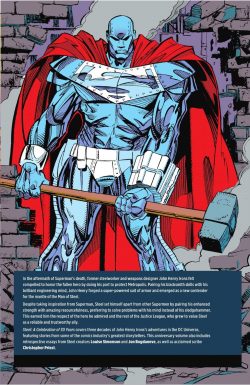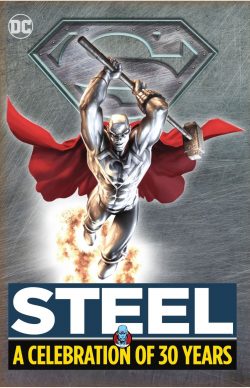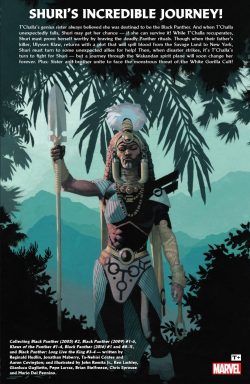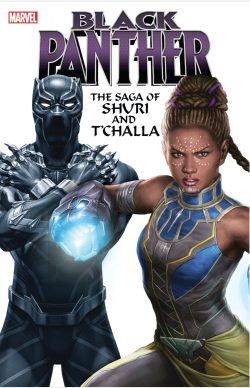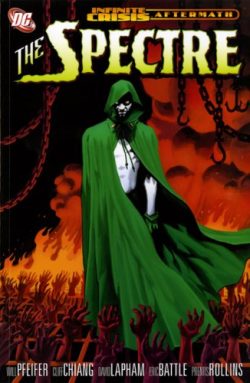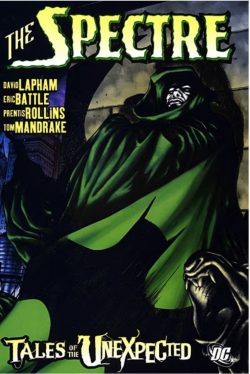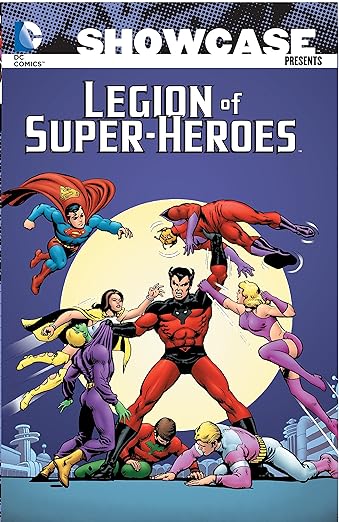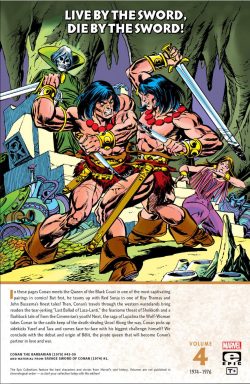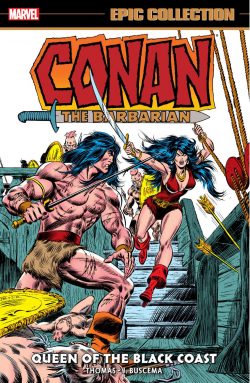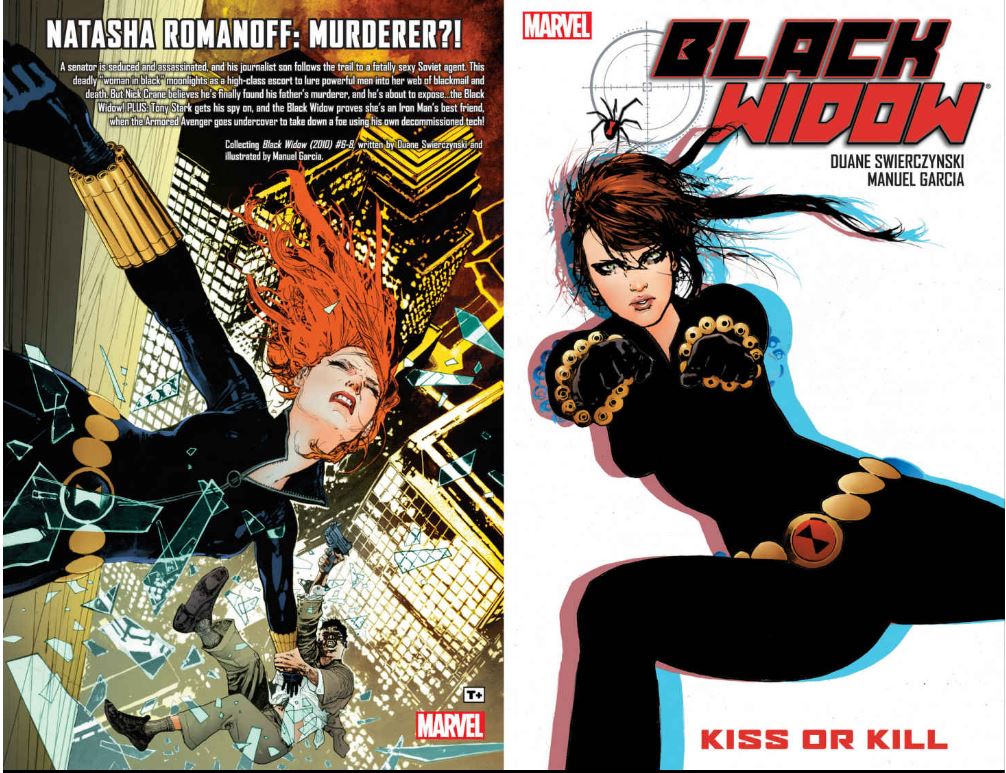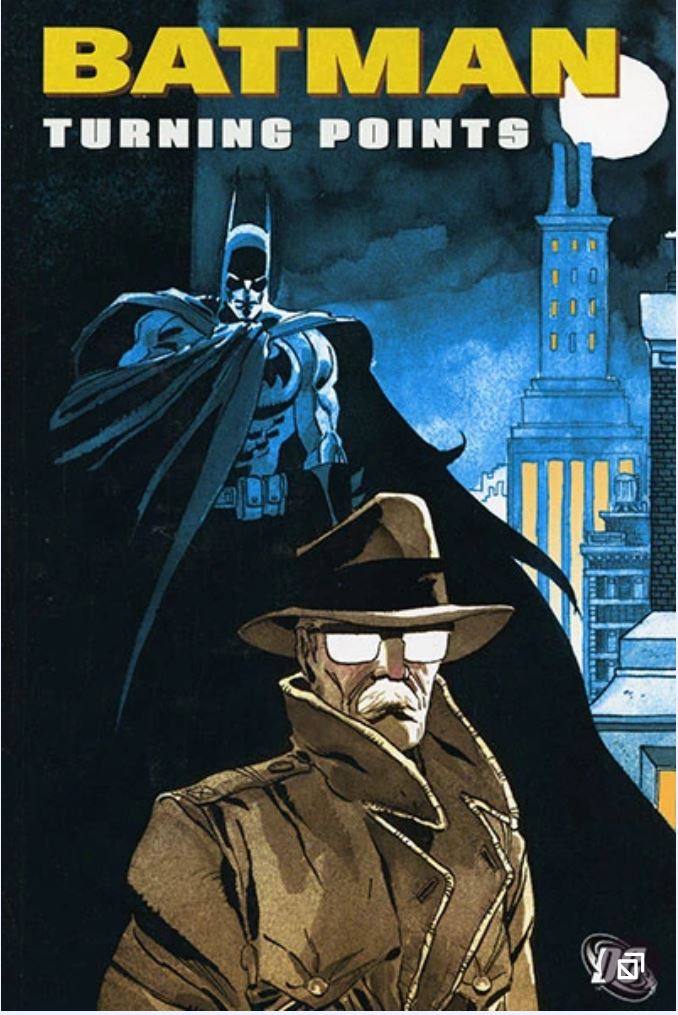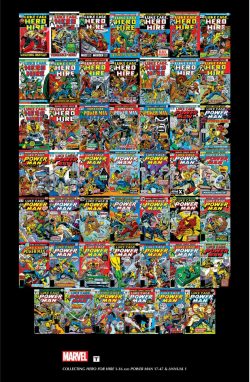
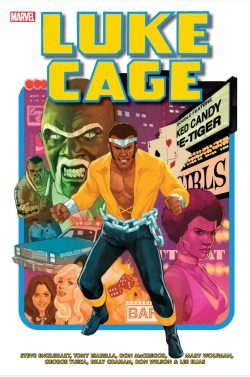
By Archie Goodwin, Steve Englehart, Tony Isabella, Len Wein, Gerry Conway, Billy Graham, Bill Mantlo, George Pérez, Marv Wolfman, Ed Hannigan, Roger Slifer, Chris Claremont, George Tuska, Ron Wilson, Lee Elias, Rich Buckler, Arvell Jones, Sal Buscema, Frank Robbins, Marie Severin, Bob Brown & various (MARVEL)
ISBN: 978-1-3029-4496-4 (HB/Digital edition)
In 1968 the consciousness-raising sporting demonstration of “Black Power” at the Olympic Games galvanised and politicised a generation of youngsters. By this time most comics companies had already made tentative efforts to address what were national socio-political iniquities, but issues of race and ethnicity took a long time to filter through to impressionable young minds avidly absorbing knowledge and attitudes via four-colour pages that couldn’t even approximate the skin tones of African Americans.
As with television, breakthroughs were small, incremental and too often reduced to a cold-war of daringly liberal “firsts”. Excluding a few characters in jungle comic books of the 1940s and 1950, Marvel clearly led the field with a black soldier in Sgt. Fury’s Howling Commandos team – the historically impossible Gabe Jones who debuted in #1, May 1963, and by my reckoning the first recurring African American in comic books. So unlikely a character was ol’ Gabe that he was as a matter of course re-coloured Caucasian at the printers who clearly didn’t realise his ethnicity, but knew he couldn’t be un-white. Jones was followed by actual negro superheroes Black Panther in Fantastic Four#52 (July 1966), and The Falcon in Captain America #117 (September 1969).
America’s first black hero to helm his own title had come (and gone largely unnoticed) in a little remembered or regarded title from Dell Comics. Created by artist Tony Tallarico and scripter D.J. Arneson and debuting in December 1965, Lobo was a gunslinger in the old wild west, battling injustice just like any cowboy hero would. Arguably a greater breakthrough was Marvel’s Joe Robertson, City Editor of The Daily Bugle; an erudite, brave and proudly ordinary mortal distinguished by his sterling character, not costume or skin tone. He first appeared in Amazing Spider-Man # 51 (August 1967), proving in every panel that the world wouldn’t end if black folk and white folk occupied the same spaces…
This big change had grown slowly out of raised social awareness during a terrible time in American history but things today don’t seem all that different, except the bile and growing taste for violence is turned towards European accents, or health workers and shop staff as well as brown skins…
As the 1960s turned, more positive and inclusive incidences of ethnic characters appeared in the US, with DC finally getting an African America hero in John Stewart (Green Lantern #87, December 1971/January 1972) – although his designation as a replacement Emerald Peacekeeper might be construed as more conciliatory and insulting than revolutionary. DC’s first hero with his own title was Black Lightning, who didn’t debut until April 1977, although Jack Kirby had introduced Vykin in Forever People #1 and The Black Racer in New Gods #3 (March and July 1971) and Shilo Norman as Scott Free’s apprentice (and eventual successor) in Mister Miracle #15 (August 1973).
As usual, it took a bold man and changing economics to really promote change. With declining comics sales intersecting a time of rising Black Consciousness, cash – if not cashing in – was probably the trigger for “the Next Step”. Contemporary “Blaxsploitation” cinema and novels had invigorated commercial interests throughout America, and in that atmosphere of outlandish dialogue, daft outfits and barely concealed – but certainly justified – outrage, an angry black man with a shady past and apparently dubious morals must have felt like a sure-fire hit to Marvel’s bosses. Luke Cage, Hero for Hire launched in the summer of 1972. A year later, The Black Panther finally got his own series in Jungle Action #5 and Blade: Vampire Hunter debuted in Tomb of Dracula #10.
This stunning compendium collects Hero for Hire #1-16, Luke Cage Power Man #17-48 and Annual #1: a landmark breakthrough series cumulatively spanning June 1972 to October 1977 and begins with Lucas, a hard-case inmate at brutal Seagate Prison. Like all convicts, he says he was framed and his uncompromising attitude makes mortal enemies of savage, racist guards Rackham and Quirt, and doesn’t endear him to the rest of the prison population such as genuinely bad guys Shades and Comanche either…
‘Out of Hell… A Hero!’ was written by Archie Goodwin and illustrated by George Tuska & Billy Graham (with initial input from Roy Thomas and John Romita) and sees a new warden arrive promising to change the hell-hole into a properly administered correctional facility. Having heard the desperate con’s tale of woe, prison doctor Noah Burstein convinces Lucas to participate in a radical experiment in exchange for a parole hearing…
Lucas had grown up in Harlem, a tough kid who managed to stay honest even when his best friend Willis Stryker had not. They remained close even though walking different paths – until a woman came between them. To be rid of his romantic rival, Stryker planted drugs and had Lucas shipped off to jail. While he was there his girl Reva – who had never given up on him – was killed when she got in way of bullets meant for up-and-coming gangster Stryker…
With nothing to lose, Lucas undergoes Burstein’s process – experimental cell-regeneration – but Rackham sabotages the process, hoping to kill the con before he can expose their illegal treatment of convicts. The equipment goes haywire and something incredible occurs. Lucas – panicked and now somehow super-strong – punches his way out of the lab and through prison walls, only to face a hail of gunfire. His body plunges over a cliff and is never found.
Months later, a vagrant prowls the streets of New York City and stumbles into a robbery. Almost casually he downs the felon, accepts a reward from the grateful victim and has a bright idea. Strong, bullet-proof, street-wise and honest, Lucas will hide in plain sight while planning his revenge on Stryker. Since his only skill is fighting, he becomes a private paladin – a Hero for Hire…
Making allowances for the colourful, often ludicrous dialogue necessitated by the Comics Code’s sanitising of “street-talking Jive”, this is probably the grittiest origin tale of the classic Marvel years, with the tense action continuing in ‘Vengeance is Mine!’ as the man calling himself Luke Cage stalks his target. Stryker has risen quickly, now controlling a vast portion of the drug trade as the deadly Diamondback, and Cage has a big surprise in store when beautiful physician Claire Temple comes to his aid after a calamitous struggle. Thinking him fatally shot, her surprise is dwarfed by his own when Cage meets her boss. Seeking to expiate his sins, Noah Burstein runs a rehab clinic on the sordid streets of Times Square, but his efforts have drawn the attention of Diamondback, who doesn’t like someone trying to fix his paying customers…
Burstein apparently does not recognise Cage, so even though faced with eventual exposure and return to prison, the Hero for Hire offers to help the hard-pressed medics. Setting up an office above a movie house on 42nd Street, Cage meets a young man who will be his greatest friend – D.W. Griffith: nerd, film freak and plucky white sidekick. However, before Cage can settle in, Diamondback strikes and the age-old game of blood and honour plays out the way it always does…
HFH #3 introduces Cage’s first returning villain in ‘Mark of the Mace!’ as Burstein – for his own undisclosed reasons – keeps Cage’s secret, whilst disgraced soldier Gideon Mace launches a terror attack on Manhattan. With his dying breath, one of the mad Colonel’s troops hires Cage to stop the attack, which he does in explosive fashion. Inker Billy Graham graduated to full art chores for ‘Cry Fear… Cry Phantom!’ in #4, wherein a deranged, deformed maniac carries out random assaults in Times Square. Or is there perhaps another motive behind the vicious attacks?
Steve Englehart took over as scripter and Tuska returned to pencil ‘Don’t Mess with Black Mariah!’ in the next issue: a tale of organised scavengers which also introduced unscrupulous reporter Phil Fox: an unsavoury sneak with greedy pockets and a nose for scandal. In ‘Knights and White Satin’ (Englehart, Gerry Conway, Graham & Paul Reinman) the swanky, ultra-rich Forsythe sisters hire Cage to bodyguard their dying father from a would-be murderer too impatient to wait the week it will take for the old man to die from a terminal illness.
This more-or less straight mystery yarn (if you discount a madman and killer robots) is followed by ‘Jingle Bombs’ – a strikingly different Christmas tale from Englehart, Tuska & Graham, before Cage properly enters the Marvel Universe in ‘Crescendo!’ Here he is hired by Doctor Doom to retrieve rogue androids that have absconded from Latveria. They are hiding as black men among the shifting masses of Harlem and the Iron Dictator needs someone who knows that unfamiliar environment. Naturally, Cage accomplishes his mission, only to have Doom stiff him for the fee. Big mistake…
‘Where Angels Fear to Tread!’ (#9) finds the enraged Hero for Hire borrowing a vehicle from the Fantastic Four to play Repo Man in Doom’s own castle, just in time to get caught in the middle of a grudge match between the tyrant and alien invader the Faceless One. It’s then back to street-level basics in ‘The Lucky… and the Dead!’ as Cage takes on a gambling syndicate led by schizophrenic Señor Suerte, who doubles his fortunes as murderous Señor Muerte (that’s Mr. Luck and Mr. Death to you): a 2-part thriller with rigged games and deathtraps climaxing in ‘Where There’s Life…!’ as Phil Fox finally uncovers Cage’s secret…
HFH #12 featured the first of many clashes with alchemical villain ‘Chemistro!’, after which Graham handled full art duties with ‘The Claws of Lionfang’ – a killer using big cats to destroy his enemies prior to Cage tackling hyperthyroid lawyer Big Ben Donovan in ‘Retribution!’ as the tangled threads of the fugitive’s murky past slowly become a noose around his neck. ‘Retribution: Part II!’ sees Graham and Tony Isabella sharing the writer’s role as many disparate elements converge to expose Cage. The crisis builds as Quirt kidnaps Luke’s girlfriend, and Seagate escapees Comanche and Shades stalking him whilst New York cops hunt him. The last thing the Hero for Hire needs is a new super-foe, but that’s just what he gets in #16’s ‘Shake Hands with Stiletto!’ (Isabella, Graham & Frank McLaughlin): a dramatic finale that literally brings the house down and clears up most of the old business.
Luke Cage, Hero For Hire was probably Marvel’s edgiest series, but after a few years tense action and peripheral interactions with the greater Marvel Universe led to a minor rethink and the title was altered, if not the basic premise. The private detective motif proved a brilliant stratagem in generating stories for a character perceived as a reluctant champion at best and outright antihero by nature. His job allowed Cage to maintain an outsider’s edginess but also meant adventure literally walked through his shabby door every issue. However, following the calamitous clash with his oldest enemies, most old business was settled and a partial re-branding of America’s premier black crusader began in issue #17. The mercenary aspect was downplayed (at least on covers) as Len Wein, Tuska & Graham gave Luke Cage, Power Man a fresh start during tumultuous team-up ‘Rich Man: Iron Man… Power Man: Thief!’
Here the still “For Hire” hero is commissioned to test Tony Stark’s security… by stealing his latest invention. Sadly, neither Stark nor his alter ego Iron Man know anything about it and the result is another classic hero-on-hero duel. Vince Colletta signed on as inker with #18’s ‘Havoc on the High Iron!’, and Cage battles high-tech killer Steeplejack whilst the next two issues offered the wanted man a tantalising chance to clear his name. ‘Call Him… Cottonmouth!’ debuted a crime lord with inside information of the frame-up perpetrated by Willis Stryker. Tragically, hope of a new clean life is snatched away despite Cage’s explosive efforts in the Isabella scripted conclusion ‘How Like a Serpent’s Tooth…’
Isabella, Wein, Ron Wilson & Colletta crafted ‘The Killer With My Name!’ as Cage is ambushed by Avengers villain Power Man, who understandably wants his nom de guerre back. He changes his mind upon waking up from the resultant bombastic battle that ensues, after which psychotic archfoe Stiletto returns beside his equally high-tech balmy brother Discus in ‘The Broadway Mayhem of 1974’ (Isabella, Wilson & Colletta), subsequently revealing a startling connection to Cage’s origins.
All this constant carnage and non-stop tension sent sometime-romantic interest Claire Temple scurrying for points distant, and in LCPM #23, Cage and D.W. go looking for her, promptly fetching up in a fascistic planned community run by old foe deranged military terrorist Mace in ‘Welcome to Security City’ (inked by Dave Hunt). This fed directly into a 2-part premier for another African American superhero as Cage and D.W. track Claire to the Ringmaster’s Circus of Crime in #24’s ‘Among Us Walks… a Black Goliath! (Isabella, Tuska & Hunt)…
Bill Foster was a highly educated black supporting character: a biochemist who worked with Henry Pym (scientist-superhero known as Ant-Man, Giant-Man, Goliath and Yellowjacket over decades of costumed capers). Foster first appeared in Avengers #32 (September 1966), before fading from view when Pym eventually regained his size-changing abilities. Carrying on his own size-shifting research, Foster was now trapped as a giant, unable to attain normal size, and Cage discovered he was also Claire’s former husband. When he became stuck at 15 feet tall, she had rushed back to Bill’s colossal side to help find a cure.
When Luke turned up, passions boiled over, resulting in another classic heroes-clash moment until the mesmeric Ringmaster hypnotised all combatants, intent on using their strength to feather his own three-ring nest. ‘Crime and Circuses’ (Isabella, Bill Mantlo, Wilson & Fred Kida) saw the good guys helpless until Claire came to the rescue, before making her choice and returning to New York with Luke. Foster soon thereafter won his own short-run series, becoming Marvel’s fourth African American costumed hero under the heavy-handed and rather obvious sobriquet Black Goliath…
Timely spoofing of a popular ‘70’s TV show inspired ‘The Night Shocker!’ (Englehart, Tuska & Colletta) as Cage stalks an apparent vampire attacking 42nd Street patrons, after which a touching human drama finds Cage forced to subdue a tragically simple-minded but super-powered wrestler in ‘Just a Guy Named “X”!’ (by Mantlo, George Pérez & Al McWilliams, and paying tribute to Steve Ditko’s classic yarn from Amazing Spider-Man #38).
A new level of sophistication, social commentary and bizarre villainy began in issue 28 as Don McGregor started his run of macabre crime sagas, opening when Cage meets ‘The Man Who Killed Jiminy Cricket!’ (illustrated by Tuska & Colletta).
Hired by a chemical company to stop industrial espionage, Luke fails to prevent the murder of his prime suspect and is somehow defeated by deadly weirdo Cockroach Hamilton (and his beloved shotgun “Josh”). Left for dead in one of the most outré cliffhanger situations ever seen, Cage took two issues to escape as the next issue featured a “deadline-doom” fill-in tale. Courtesy of Mantlo, Tuska & Colletta, Luke Cage, Power Man #29 revealed that ‘No One Laughs at Mr. Fish!’ (although the temptation is overwhelming) as Cage fights a fin-faced mutated mobster robbing shipping trucks for organised crime analogue The Maggia, after which the story already in progress resumes in #30 with ‘Look What They’ve Done to Our Lives, Ma!’ (by McGregor, Rich Buckler, Arvell Jones & Keith Pollard).
Escaping from a deadly deathtrap, Cage hunts down Hamilton, and confronts his erudite, sardonic, steel-fanged boss Piranha Jones just after they succeed in stealing a leaking canister of deadly nerve gas. The dread drama concludes in ‘Over the Years They Murdered the Stars!’ (Sal Buscema & the legion of deadline-busting Crusty Bunkers) as Cage saves his city at the risk of his life before serving just deserts to the eerie evildoers…
Having successfully rebranded himself, the urban privateer made ends meet whilst seeking a way to stay under police radar and clear his name. The new level of sophisticated, social commentary and bizarre villainy when McGregor took over writing led to Cage saving the entire city in true superhero style as #32 opens with the (unlicensed) PI in the leafy suburbs, hired to protect a black family from literally incendiary racist super-villain Wildfire in ‘The Fire This Time!’ (illustrated by Frank Robbins & Colletta). This self-appointed champion of moral outrage is determined to keep his affluent, decent neighbourhood white, and even Power Man is ultimately unable to prevent a ghastly atrocity from being perpetrated…
Back in the comfort zone of Times Square again, Cage is in the way when a costumed manic comes looking for Noah Burnstein, and painfully learns ‘Sticks and Stone Will Break Your Bones, But Spears Can Kill You!’ As shady reporters, sleazy lawyers and police detective Quentin Chase all circle, looking to uncover the Hero for Hire’s secret past in ‘Death, Taxes and Springtime Vendettas!’ (Frank Springer inks), Cage’s attention is distracted from Burstein’s stalker by deranged wrestler dubbed The Mangler, which leads to a savage showdown and near-fatal outcome in ‘Of Memories, Both Vicious and Haunting!’ (plotted by Marv Wolfman, dialogued by McGregor and illustrated by Marie Severin, Joe Giella & Frank Giacoia). Here at last, the reasons for the campaign of terror against the doctor are finally, shockingly exposed…
Power Man Annual #1 (1976) follows with ‘Earthshock!’ – by Chris Claremont, Lee Elias & Hunt – taking Cage to Japan as bodyguard to wealthy Samantha Sheridan. She’s being targeted by munitions magnate and tectonics-warping maniac Moses Magnum, intent on tapping Earth’s magma core, even though the very planet is at risk of destruction. Thankfully, not even his army of mercenaries is enough to stop Cage in full rage…
Next comes the cover for Power Man #36 (cover-dated October 1976) and another casualty of the “Dreaded Deadline Doom”, reprinting #12: the debut of the villain who follows in #37’s all-new ‘Chemistro is Back! Deadlier Than Ever!’ by Wolfman, Wilson & A Bradford. Here the apparently grudge-bearing recreant attacks Cage at the behest of a new mystery mastermind who clarifies his position in follow-up ‘…Big Brother Wants You… Dead!’ (Wolfman, Mantlo, Bob Brown & Jim Mooney). His minions Cheshire Cat and Checkpoint Charlie shadow the increasingly frustrated investigator, before repeated inconclusive and inexplicable clashes with Chemistro lead to a bombastic ‘Battle with the Baron!’ (inked by Klaus Janson) – a rival mastermind hoping to corner the market on crime in NYC. The convoluted clash concludes in ‘Rush Hour to Limbo!’ (Wolfman, Elias & Giacoia) as one final deathtrap for Cage turns into an explosive last hurrah for Big Brother and his crew…
Inked by Tom Palmer, #41 debuts a new vigilante in ‘Thunderbolt and Goldbug!’ as a super-swift masked hero makes a name for himself cleaning up low-level scum. Simultaneously, Cage is hired by a courier company to protect a bullion shipment, but when the truck is bombed and the guards die, dazed and furious Cage can’t tell villain from vigilante and takes on the wrong guy…
Answers if not conclusions are forthcoming in ‘Gold! Gold! Who’s Got the Gold?’ (with Alex Niño on inks) as Luke learns who his real friends and foes are, only to be suckered into a lethal trap barely escaped in #43’s ‘The Death of Luke Cage!’ In the aftermath, with legal authorities closing in on his fake life, Cage flees town and sheds his Power Man persona. However, even in the teeming masses of Chicago he can’t escape his past as an old enemy mistakenly assumes he’s been tracked down by the hero he hates most in all the world. Wolfman plots and Ed Hannigan scripts for Elias & Palmer as ‘Murder is the Man Called Mace!’ sees Luke dragged into the dishonoured soldier’s scheme to seize control of America and – despite his best and most violent efforts – beaten and strapped to a cobalt bomb on ‘The Day Chicago Died!’ (Wolfman & Elias). Sadly, after breaking free of the device, it’s lost in the sewers, prompting a frantic ‘Chicago Trackdown!’ before another savage showdown with Mace and his military madmen culminate in a chilling ‘Countdown to Catastrophe!’ (scripted by Roger Slifer) as a fame-hungry sniper starts shooting citizens whilst the authorities are preoccupied searching for the missing nuke…
With atomic armageddon averted at the last moment, this collection – and Cage’s old life – end on a well-conceived final charge. With issue #48, Cage’s comics title would be shared with mystic martial artist Danny Rand in the superbly enticing odd couple feature Power Man and Iron Fist, but before that there’s still a ‘Hot Time in the Old Town Tonight!’ courtesy of Claremont, Tuska & Bob Smith as Chicago is attacked by brain-sucking electrical parasite Zzzax! Thankfully, our steel-skinned stalwart is more than a match for the mind-stealing megawatt monstrosity…
With all covers – by Romita, Graham, Gil Kane, Wilson, Rich Buckler, Dave Cockrum, Marie Severin, Ernie Chan, Jim Starlin, Mike Esposito, Frank Giacoia, Klaus Janson, Dan Adkins, Tom Palmer, Joe Sinnott & Pablo Marcos – ; retrieved Introductions ‘An Optimistic Time’ by Englehart, ‘Always Forward’ by Isabella and ‘Luke Cage and the Big Bad City’ by McGregor and – from #3 onwards – letters pages ‘Comments to Cage’, the street level drama is augmented by a treasure trove of extra features. Adding value are the cover of reprint one-shot Giant-Size Power Man from 1975; Marvel Bulletins page promo from May 1972; House ads; original art pages and covers by Romita, Graham, Kane, Brown, pre-corrected production photostats, and Cockrum & Romita’s Cage entry from the 1975 Mighty Marvel Calendar (March, in case you were wondering) as well as the same by Sal Buscema from the Mighty Marvel Bicentennial Calendar (1976) and Wilson & Sinnott’s June 1977 Marvel Comics Memory Album Calendar before ending with the cover art for this collection by Phil Noto.
Arguably a little dated now (us in the know prefer the term “retro”), these tales were crucial in breaking down many social barriers across the complacent, intolerant, WASP-flavoured US comics landscape, and their power – if not their initial impact – remains undiminished to this day. These are tales well worth your time and attention.
© 2022 MARVEL.
